

![]()
In his final year at school Gideon studied English, Pure and Applied Mathematics, Chemistry, Physics, History and French.
At University, Gideon obtained a BSc (Hon) from the University of Tasmania, majoring in Zoology and Chemistry, with first class honors in Chemistry. Gideon's PhD is in Biochemistry from Flinders University in Adelaide.
Since finishing his PhD, Gideon has worked in the following places: 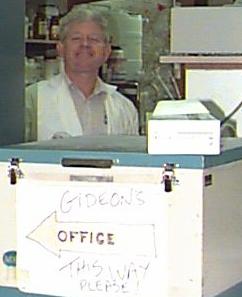
In his spare time Gideon enjoys music, literature, bushwalking and especially painting. He paints landscapes and figurative abstractions in oil, acrylic and water colour; Gideon says that he has painted hundreds of paintings and drawn thousands of portraits.
(Author's note: Gideon is the closest to the image of a 'zany scientist' of any of the Biochemistry senior staff. He's an interesting person who loves a chat about almost any topic - but Jane Austen and historical politics are special favourites.)
Interviewer: Can you describe briefly how you are doing whatever you do?
Dr Polya: Once we have isolated a protein with useful biological properties we determine its primary structure and construct a probe to use in the isolation of its gene. When we have the gene we can insert that into a vector which will deliver the gene to a crop plant. We need to use techniques of protein chemistry in working with the proteins, genetic biotechnology in working with the genes and mycology (the study of fungi), entomology (the study of insects), plant physiology and biochemistry in investigating the activity of these gene products.
Interviewer: Who or what (animal or plant) will benefit from your research/techniques?
Dr Polya: The people who depend on the crop plants we are trying to improve will benefit. This includes farmers in developed countries as well as the people in the developing world who would benefit if better strains of their food plants became available.
Interviewer: What are the economic implications of your applied genetics? (How expensive is it to do? What will be/are the cost benefits of the outcome?)
Dr Polya: The research to the stage of characterising the proteins and their genes will cost up to $ half a million in the laboratory. The development of transgenic plants, including field trials and the like, will cost another $ 2-5 million.
On the other hand, particular crops with better yields, both in quantity and quality, could be estimated to be worth more than $100 million per annum.
So whilst the development of a project such as this is expensive, the benefits, both social and financial, are potentially huge.
Interviewer: Historically, what is the scientific background to the research you are now doing?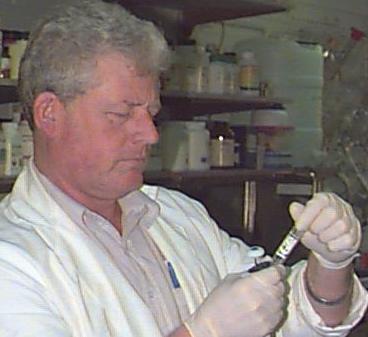
With the development of the new genetic engineering technology it became possible to try to put the genes for these proteins into crop plants. The goal is to make transgenic crop plants which express the protective proteins not only in seeds, but in other plant tissue as well. If several defensive proteins can be produced in the host plants we will have developed superior plants with multiple defenses.
Interviewer: For a Year 12 Biology student to understand what you are doing, some background knowledge of biological concepts will be needed. Can you tell me what biology is relevant to what you are doing, and why?
Dr Polya: In discussing this work there are many concepts of molecular biology which need to be understood.
The relationships between DNA structure, the transcription of the genes to give mRNA, and the translation of the mRNA code in protein synthesis are all fundamental to this work.
In addition to that, an understanding of the relationship between a protein's primary structure and its final 3-dimensional shape are needed to define 'how' a defensive protein may act and the biochemical targets it is likely to act upon.
Students also need to know about the enzymes used in the work we do:
Interviewer: I now need to know something of the techniques used in your research. Can you tell me what techniques are important, and why they are important?
Dr Polya: Let's start with a flow chart which sets out the steps in order.
![]()
![]()
Determine primary sequence
of the protein.
(Chemical methods used)
![]()

Construct oligonucleotide probes
![]()

Use oligonucleotide primer and PCR to
isolate and amplify the gene of interest.
![]()

Use restriction enzymes and DNA ligase to insert
the gene (coloured red) into a plasmid
which also carries a marker gene (coloured blue) for antibiotic resistance.
![]()

Use a "DNA gun" to insert the plasmid
into a plant cell
![]()

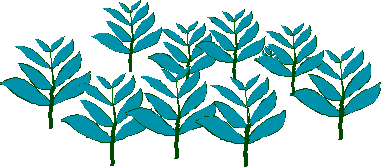
![]()
The first steps in this process use techniques of protein chemistry and plant, insect and fungal biochemistry in determining the structure and function of the useful proteins.
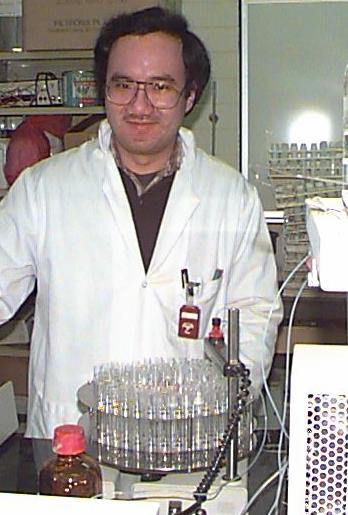
[At right: Dr Roland Chung, a Postdoctoral Research Fellow in Gideon's lab, seems happy to have so many tubes of protein to examine!]
Once we know the primary structure, or amino acid sequence of the protein we are able to construct a complementary DNA sequence to it. This oligonucleotide can be used as a gene probe That is, it can be used to 'search for' the corresponding DNA base sequence in the DNA of the plant. Once the gene is located, PCR can be used to make multiple copies of it.
We use the probe, and the PCR reaction to isolate and amplify the DNA we are interested in.
Then, using DNA sequencing, we confirm that the gene and the protein we started with, do match up. The nucleotide sequence in the DNA should correspond to the amino acid sequence in the protein, noting, however, that this is not always precisely true. The protein may have been "processed", through the deletion of pieces at either end. Mass spectrometry can very precisely tell us the mass of the protein and we can thus determine what bits are missing.
The gene is then spliced into the DNA of a plasmid vector, using restriction enzymes to create sticky ends on the cut pieces of DNA and the enzyme DNA ligase to reconnect those sticky ends as we need.
The vector, which carries an antibiotic resistance gene to enable selection of a properly engineered plasmid callus tissue. The plant callus is a small plug of tissue growing on agar which can ultimately yield a mature plant. There are various ways of inserting the plasmid into the callus this, but we can use particle bombardment using a DNA gun.
The transgenic plants are grown up and tested for gene expression - do they produce the protein we are hoping for? The plants are also tested for biological activity, for example, is the protein active in retarding fungal growth or insect attack?
The final stages in the process, the field trials, are not done by us. By this stage, the development of the plants is done by the agricultural companies who have the facilities for such work.
Interviewer: What do you see as the major biological implications of the work you are doing? For example; are genotypes or phenotypes being altered?, is a species survival potential increased?, will someone or something have a better quality of life?
Dr Polya: Research such as this, aiming to develop more productive crop plants, is designed to benefit the people who rely on those crops.
These benefits can be at many levels. If the crops are used for food, especially in the world's poor nations, where poverty and large populations can be found, then better food crops should help feed the people. In more wealthy nations, the farmers may benefit from higher yields, and the consumers may benefit from higher quality products.
By introducing new genes into species of crop plants, there is certainly a change in genotype and phenotype of those plants - that is exactly what we set out to do. Whether that will have an effect on the survival of the species is hard to say. Humans have been selectively breeding plants for particular characteristics for many years, and it is true that some crop species are now very different from their wild ancestors. Does this represent an increased survival of the cultivars, or a decreased survival of the wild species? It's probably a little of both.
Interviewer: There is often discussion or debate about issues associated with biotechnology. What is one such issue relating to your work? Can you outline the arguments of the opposing sides of the debate please?
Dr Polya: There is some debate about whether or not genetically engineered food products should be produced at all. The arguments concerning this range from theological, to economic, social and biological. Here's a summary of some of these arguments:
| Question | Arguments for | Arguments against |
|---|---|---|
| Is alteration of an organism's genotype 'playing God'? | Yes, where unnatural constructs are produced with unforeseen potentialities. | No, mutation and recombination occur anyway, so this is merely directing natural events. |
| Is it appropriate for companies to patent transgenic plants and profit from them? | Yes, the companies invest millions in development of the product, they have a right to get a reasonable return on that money. They can use some of the profit to develop more products. | No, not where the companies' control of a product is socially discriminatory, harmful, exploitative or in violation of indigenous rights. |
| Are genetically engineered foods 'safe'? | Yes, gene products are proteins which are digested by humans. Genes cannot 'jump' between plant and animal species. | No, 'safe' is a relative term. Is breathing urban air 'safe'? There is always a small possibility of unforeseen consequences. |
| Should genetically engineered food products be labelled? | Yes, people should have the ability to make a choice. | No, there is so much misinformation and disinformation in the community that people will be caused to panic and food which is potentially healthier for us will not be accepted. |
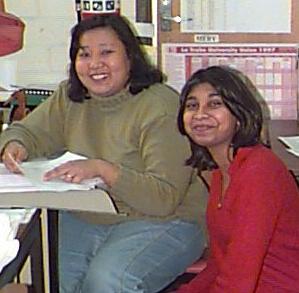
For ideas on where you might find additional resource material, look again at the section Resources on another page at this site. And don't forget the power of the Internet to provide you with information. A well thought out search, using a search engine such as Alta Vista, should provide more information than you can possibly use!
Please do not phone Dr Polya for further information for your CAT. He, like the rest of the staff in Biochemistry, is a busy person. However, if you think we can help you some more, use either the comment form or the email address for this site and we will do what we can.
If you would like to read another interview with a La Trobe Biochemistry scientist, you can click here to go back to the Interview Index.
If you would like to 'netsurf' for some more resources, you might find the author's favourite Biology Bookmarks helpful.
Click on Kick-the-cat to return to the VCE Biology Students' Home Page
![]()
This page is maintained by Jenny Herington, who can be contacted at bio_cat@bioserve.latrobe.edu.au by email.
All of the pages at the VCE Biology Students' site are copyright © Biochemistry, La Trobe University.
Last update :22 July 1997